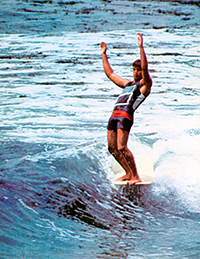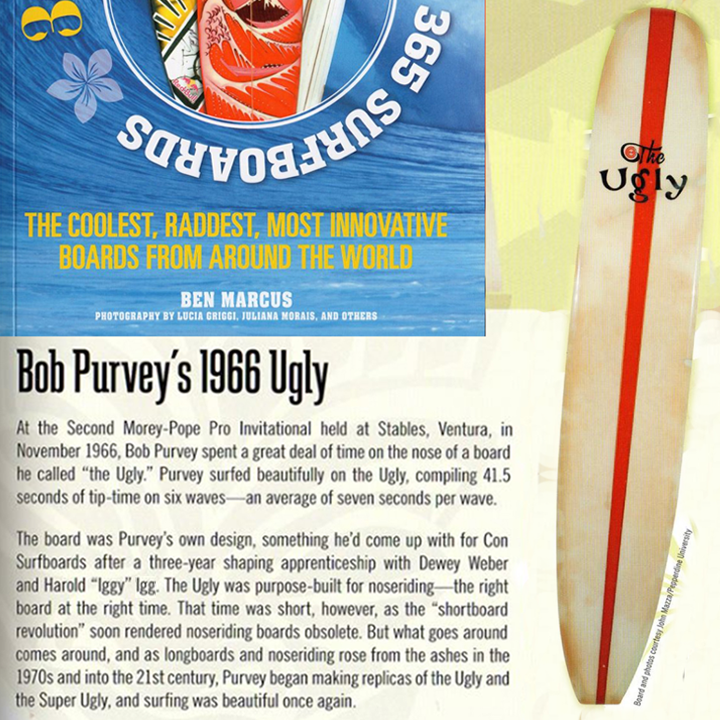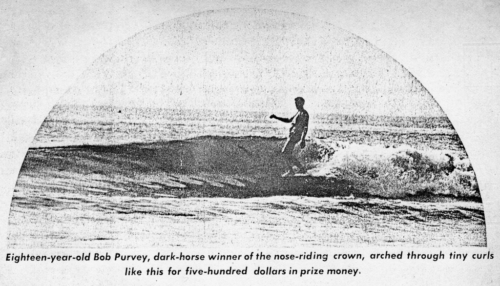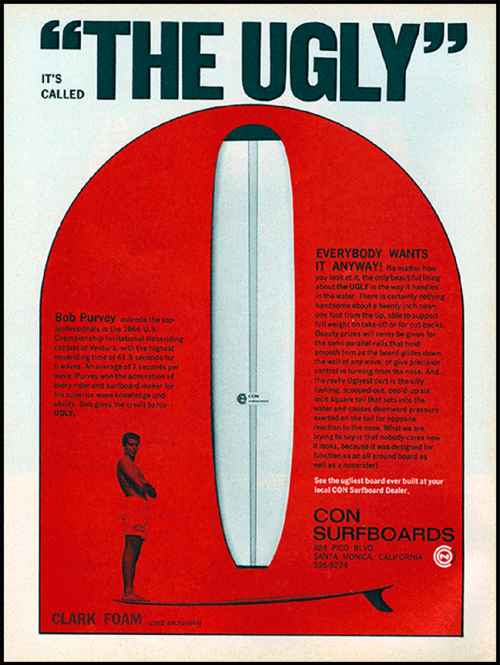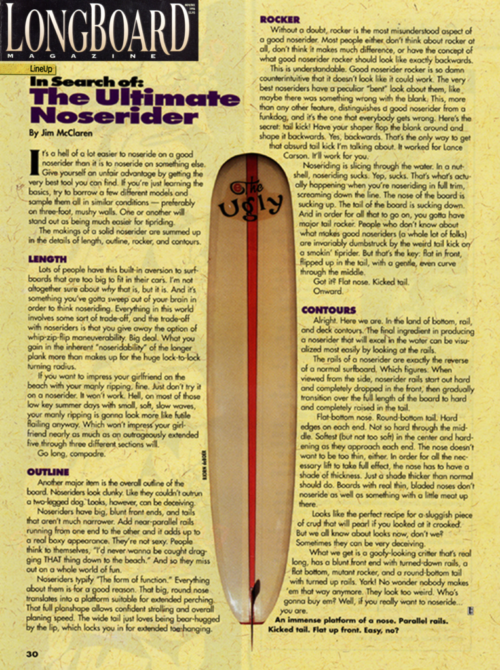Bob Purvey introduces The Ugly noserider at the 1966 Morey-Pope Professional Invitational Championships noseriding contest.
It‘s dawn on Friday, the 11th of November 1966, when the Morey-Pope Professional Invitational US Championships is about to begin. The three-day invitational surfing contest will test surfing disciplines with timed wave ride length and noserides (considered the quintessential maneuver in a surfer’s repertoire).
The invitational format designed for professionals costs $125 to enter to contend for a $5,000 cash purse. A two to four-foot North-West swell at the “Stables” point break, about a quarter-mile north of California Street in Ventura, California, provided a fair challenge. An objective judging system evaluates the skill test by timing using stopwatches.
The first professional contest in the sport’s history was held the year before, in 1965, at California Street. The judging format then, in 1965, was purely noseriding for time, simple, and nothing else. The objective judging system defuses the many arguments about the subjective, personality-driven, and often unfair point system used in most surfing contests.
Since the formation of the United States Surfing Association in 1961, the parent body organizing surfing contests around the United States, arguments over various judging measures used in the subjective points
system judging style and tricks seemed to favor personalities rather than skills. Timing noserides was declared the fair, objective way to evaluate a surfer’s skill set. After all, noseriding is the quintessential maneuver on a longboard. It took all of one’s repertoire to achieve excellence and became the definition of style in modern longboard surfing by 1966.
For the second professional contest, an audience of about two thousand gathered, paying $1 each to enter the closed-off beach area to see the performances of famous surfers invited worldwide and learn more about surfing at its best.
The objective judging system utilizes a stopwatch to determine the cumulative time on the nose while facing the challenge of riding a wave. There are no points, nothing to do with style, simply time on the clock and nose. Easy to understand by even non-surfers.
Money is the prize for the second time in the sport’s history. It‘s the hottest promotion in the surfing industry and the brainchild of well-known inventor Tom Morey and partner Peter Pope. The second contest
addresses the need for objective judging in the sport to qualify for the Olympics and also displays the artistry of surfing. It appeals to the masses and demonstrates the best surfing skills in their best form.
Day one: Time for the length of the ride demonstrates a competitor‘s ability to master the whole wave from the take-off when the wave first crests through the distance to the beach. The clock runs from
when the contestant stands up on his surfboard to when he pulls out of the wave. Day two: Noseriding for time pushes the competitor‘s skills at maneuvering the surfboard from their front end (the nose area), measured at 25% of the overall surfboard length. The third and final day combines both accumulated nose time and wave time. Each of the fifty champion competitors intends to push nose-time to the extreme to show off their most spectacular poses to get the most stunning photo-ops into the magazines and, of course, enough time to win the contest. There is no overall surfboard length limitation. The nose size rule is simple: The nose area is 25% of the overall surfboard length, with no length limitation.
In the 1965 contest, this rule promoted experimentation among many contest surfers and their surfboard design teams. It also led to some extraordinary devices, mostly appearing in the initial contest in 1965:
World Champion Mike Doyle had a 2″x4″x8′ wood plank rosined to the tail to gain overall length and a greater associated 25% nose area. A 10-pound barbell was duct-taped to the tail of another surfboard, and yet another had a brick rosined to the tail – both inventions were hoping to keep the rear weighed down and, thus, the nose rising. Nose shapes varied from flat bottom to concave, narrow to comprehensive, and flat rocker to prominent rockers. A cross “Wing” was attached to one fin, while another fin had a funnel
running through it.
In 1965, many new surfboard inventions were introduced, specifically for noseriding. The Ugly incorporated all the noseriding design elements introduced in 1966 for the second and last invitational.
The second contest had its share of oddities, but they seemed more thought out. Designers learned from the first contest that a surfboard could not just be lengthy to gain more nose area, thinking they could
get more nose time. Surfboards also had to turn to nose ride and maintain position in the wave’s pocket, where the nose gains the most lift. What became clear was that surfboard designs were advancing in many different directions. Designers were experimenting to find the common denominator that enabled the surfboard to maneuver from the nose and, in so doing, were discovering other surfboard functionalities. This contest may have been one of the most revolutionary in developing surfboard designs, inadvertently promoting short-board inventions that revolutionized the sport for the following decade.
The shortboard revolution that followed sacrificed walking the longboard on small waves for turning the shortboard to gain the necessary speed and face the infrequent challenge of storm-driven big waves and
the adventure of finding them worldwide. Eventually, longboards came back into fashion because of the frequency of smaller waves.
Perched like casual Gods on the front end of their surfboards, striking ethereal poses in effortless motion, each competitor clocked incredible distances. The entire audience would watch, mesmerized, as the length of each nose ride increased. The audience was captivated as the clock ticked off, timing each noseride. They kept a tally while they gambled on who would win.
For three years before endorsing his new sponsor, Con Surfboards, at the beginning of 1966, highly ranked contest surfer and surfboard designer Bob Purvey had designed his surfboards under his mentor and the tutelage of world-famous surfboard builder and designer Dewey Weber and his shaper, Harold “Iggy” Igg,
Purvey learned about the essence of what typically goes into a noserider shape. It had a vast nose, long and deep concave underneath it, and a kicked-up tail. Purvey states, “The Ugly combines the concave underneath the nose and kicked up tail that makes for long noserides. The wide nose was my unique concept. Con‘s best shaper, Gary Seaman, put it all together. I could have ridden the nose on a tongue depressor, and I was that good back then. The combination of these features is what The Ugly Shape looked like, but the details that go into putting the curves together in The Ugly Shape make nose riding a heck of a lot easier and enable me to stay on the nose a heck of a lot longer. Kudos to Gary for his craftsmanship and shaping a smooth, well-balanced combination of curves.”


